The Impact of Permafrost Change on Soil Organic Carbon Stocks in Northeast China
Abstract
:1. Introduction
2. Materials and Methods
2.1. Study Area
2.2. Data Sources
2.2.1. Meteorological Data
2.2.2. DEM
2.2.3. Land Use and Land Cover
2.2.4. Soil Organic Carbon (SOC)
2.3. Data Processing Methods
2.3.1. TTOP Model
2.3.2. Regression Model [48,49]
2.3.3. Local Thin-Plate Smoothing Spline Interpolation Method
3. Results
3.1. Regression Model Adjusted GST
3.2. TTOP and Spatial Distribution of Permafrost
3.3. Changes in Soil Organic Carbon
3.4. Relationship between LULC and SOC Changes in Permafrost Degradation Areas
3.5. Relationship between Permafrost Change and SOC Change
3.6. Model Evaluation
4. Discussion
4.1. Distribution and Degradation of Permafrost
4.2. The Relationship between SOC and TTOP
4.3. SOC in Different LULC and Response to Changes in Permafrost
5. Conclusions
Author Contributions
Funding
Data Availability Statement
Conflicts of Interest
References
- Ciais, P.; Sabine, C.; Bala, G.; Bopp, L.; Brovkin, V.; Canadell, J.; Chhabra, A.; DeFries, R.; Galloway, J.; Heimann, M. Carbon and other biogeochemical cycles. In Climate Change 2013: The Physical Science Basis; Contribution of Working Group I to the Fifth Assessment Report of the Intergovernmental Panel on Climate Change; Cambridge University Press: Cambridge, UK, 2014; pp. 465–570. [Google Scholar]
- Scharlemann, J.P.; Tanner, E.V.; Hiederer, R.; Kapos, V. Global soil carbon: Understanding and managing the largest terrestrial carbon pool. Carbon Manag. 2014, 5, 81–91. [Google Scholar] [CrossRef]
- Köchy, M.; Hiederer, R.; Freibauer, A. Global distribution of soil organic carbon–Part 1: Masses and frequency distributions of SOC stocks for the tropics, permafrost regions, wetlands, and the world. Soil 2015, 1, 351–365. [Google Scholar] [CrossRef]
- Schrumpf, M.; Schulze, E.; Kaiser, K.; Schumacher, J. How accurately can soil organic carbon stocks and stocks changes be quantified by soil inventories? Biogeosciences 2011, 8, 1193–1212. [Google Scholar] [CrossRef]
- Yigini, Y.; Panagos, P. Assessment of soil organic carbon stocks under future climate and land cover changes in Europe. Sci. Total Environ. 2016, 557, 838–850. [Google Scholar] [CrossRef] [PubMed]
- Taylor, P.G.; Cleveland, C.C.; Wieder, W.R.; Sullivan, B.W.; Doughty, C.E.; Dobrowski, S.Z.; Townsend, A.R. Temperature and rainfall interact to control carbon cycling in tropical forests. Ecol. Lett. 2017, 20, 779–788. [Google Scholar] [CrossRef] [PubMed]
- Obu, J.; Westermann, S.; Bartsch, A.; Berdnikov, N.; Christiansen, H.H.; Dashtseren, A.; Delaloye, R.; Elberling, B.; Etzelmüller, B.; Kholodov, A.; et al. Northern Hemisphere permafrost map based on TTOP modelling for 2000–2016 at 1 km2 scale. Earth-Sci. Rev. 2019, 193, 299–316. [Google Scholar] [CrossRef]
- Gruber, N.; Friedlingstein, P.; Field, C.B.; Valentini, R.; Heimann, M.; Richey, J.E.; Lankao, P.R.; Schulze, E.-D.; Chen, C.-T.A. The vulnerability of the carbon cycle in the 21st century: An assessment of carbon-climate-human interactions. Scope-Sci. Comm. Probl. Environ. Int. Counc. Sci. Unions 2004, 62, 45–76. [Google Scholar]
- Hugelius, G.; Strauss, J.; Zubrzycki, S.; Harden, J.W.; Schuur, E.A.; Ping, C.-L.; Schirrmeister, L.; Grosse, G.; Michaelson, G.J.; Koven, C.D. Estimated stocks of circumpolar permafrost carbon with quantified uncertainty ranges and identified data gaps. Biogeosciences 2014, 11, 6573–6593. [Google Scholar] [CrossRef]
- Ding, J.; Chen, L.; Ji, C.; Hugelius, G.; Li, Y.; Liu, L.; Qin, S.; Zhang, B.; Yang, G.; Li, F.; et al. Decadal soil carbon accumulation across Tibetan permafrost regions. Nat. Geosci. 2017, 10, 420–424. [Google Scholar] [CrossRef]
- IPCC. Climate Change 2021: The Physical Science Basis; Masson-Delmotte, V., Zhai, P., Pirani, A., Connors, S.L., Péan, C., Berger, S., Caud, N., Chen, Y., Goldfarb, L., Gomis, M.I., et al., Eds.; Contribution of Working Group I to the Sixth Assessment Report of the Intergovernmental Panel on Climate Change; Cambridge University Press: Cambridge, UK; New York, NY, USA, 2021. [Google Scholar] [CrossRef]
- Wei, D.; Qi, Y.; Ma, Y.; Wang, X.; Ma, W.; Gao, T.; Huang, L.; Zhao, H.; Zhang, J.; Wang, X. Plant uptake of CO2 outpaces losses from permafrost and plant respiration on the Tibetan Plateau. Proc. Natl. Acad. Sci. USA 2021, 118, e2015283118. [Google Scholar] [CrossRef]
- Jin, H.; Li, S.; Cheng, G.; Shaoling, W.; Li, X. Permafrost and climatic change in China. Glob. Planet. Chang. 2000, 26, 387–404. [Google Scholar] [CrossRef]
- Jin, H.; Yu, Q.; Lü, L.; Guo, D.; He, R.; Yu, S.; Sun, G.; Li, Y. Degradation of permafrost in the Xing’anling Mountains, Northeastern China. Permafr. Periglac. Process. 2007, 18, 245–258. [Google Scholar] [CrossRef]
- Jin, H.; Ma, Q. Impacts of Permafrost Degradation on Carbon Stocks and Emissions under a Warming Climate: A Review. Atmosphere 2021, 12, 1425. [Google Scholar] [CrossRef]
- Jin, H.; He, R.; Cheng, G.; Wu, Q.; Wang, S.; Lü, L.; Chang, X. Changes in frozen ground in the Source Area of the Yellow River on the Qinghai–Tibet Plateau, China, and their eco-environmental impacts. Environ. Res. Lett. 2009, 4, 045206. [Google Scholar] [CrossRef]
- Schuur, E.A.G.; McGuire, A.D.; Schädel, C.; Grosse, G.; Harden, J.W.; Hayes, D.J.; Hugelius, G.; Koven, C.D.; Kuhry, P.; Lawrence, D.M.; et al. Climate change and the permafrost carbon feedback. Nature 2015, 520, 171–179. [Google Scholar] [CrossRef] [PubMed]
- Philipp, M.; Dietz, A.; Buchelt, S.; Kuenzer, C. Trends in satellite Earth observation for permafrost related analyses—A review. Remote Sens. 2021, 13, 1217. [Google Scholar] [CrossRef]
- Nelson, F.E.; Outcalt, S.I. A computational method for prediction and regionalization of permafrost. Arct. Alp. Res. 1987, 19, 279–288. [Google Scholar] [CrossRef]
- Cheng, G.-D. Problems on zonation of high-altitude permafrost. Acta Geogr. Sin. Beijing 1984, 39, 185–193. [Google Scholar]
- Smith, M.; Riseborough, D. Permafrost monitoring and detection of climate change. Permafr. Periglac. Process. 1996, 7, 301–309. [Google Scholar] [CrossRef]
- Che, L.; Zhang, H.; Wan, L. Spatial distribution of permafrost degradation and its impact on vegetation phenology from 2000 to 2020. Sci. Total Environ. 2023, 877, 162889. [Google Scholar] [CrossRef]
- Ran, Y.; Li, X.; Cheng, G. Climate warming over the past half century has led to thermal degradation of permafrost on the Qinghai–Tibet Plateau. Cryosphere 2018, 12, 595–608. [Google Scholar] [CrossRef]
- Lewkowicz, A.G.; Bonnaventure, P.P. Equivalent elevation: A new method to incorporate variable surface lapse rates into mountain permafrost modelling. Permafr. Periglac. Process. 2011, 22, 153–162. [Google Scholar] [CrossRef]
- Gao, B.; Yang, D.; Qin, Y.; Wang, Y.; Li, H.; Zhang, Y.; Zhang, T. Change in frozen soils and its effect on regional hydrology, upper Heihe basin, northeastern Qinghai–Tibetan Plateau. Cryosphere 2018, 12, 657–673. [Google Scholar] [CrossRef]
- Morrissey, L.A.; Strong, L.; Card, D. Mapping permafrost in the boreal forest with thematic mapper satellite data. Photogramm. Eng. Remote Sens. 1986, 52, 1510. [Google Scholar]
- Ferreira, A.; Vieira, G.; Ramos, M.; Nieuwendam, A. Ground temperature and permafrost distribution in Hurd Peninsula (Livingston Island, Maritime Antarctic): An assessment using freezing indexes and TTOP modelling. CATENA 2017, 149, 560–571. [Google Scholar] [CrossRef]
- Garibaldi, M.C.; Bonnaventure, P.P.; Lamoureux, S.F. Utilizing the TTOP model to understand spatial permafrost temperature variability in a High Arctic landscape, Cape Bounty, Nunavut, Canada. Permafr. Periglac. Process. 2021, 32, 19–34. [Google Scholar] [CrossRef]
- Ni, J.; Wu, T.; Zhu, X.; Hu, G.; Zou, D.; Wu, X.; Li, R.; Xie, C.; Qiao, Y.; Pang, Q. Simulation of the present and future projection of permafrost on the Qinghai-Tibet Plateau with statistical and machine learning models. J. Geophys. Res. Atmos. 2021, 126, e2020JD033402. [Google Scholar] [CrossRef]
- Huang, S.; Ding, Q.; Chen, K.; Hu, Z.; Liu, Y.; Zhang, X.; Gao, K.; Qiu, K.; Yang, Y.; Ding, L. Changes in near-surface permafrost temperature and active layer thickness in Northeast China in 1961–2020 based on GIPL model. Cold Reg. Sci. Technol. 2023, 206, 103709. [Google Scholar] [CrossRef]
- Romanovsky, V.; Smith, S.; Isaksen, K.; Nyland, K.; Kholodov, A.; Shiklomanov, N.; Streletskiy, D.; Farquharson, L.; Drozdov, D.; Malkova, G. Terrestrial Permafrost [in “State of the Climate in 2019”]. Bull. Am. Meteorol. Soc. 2020, 101, S265–S271. [Google Scholar]
- Romanovsky, V.; Isaksen, K.; Drozdov, D.; Anisimov, O.; Instanes, A.; Leibman, M.; McGuire, A.D.; Shiklomanov, N.; Smith, S.; Walker, D. Changing Permafrost and Its Impacts, Snow, Water, Ice and Permafrost in the Arctic (SWIPA), 2017; Arctic Monitoring and Assessment Programme (AMAP): Oslo, Norway, 2017; pp. 65–102. [Google Scholar]
- Fu, Z.; Wu, Q.; Zhang, W.; He, H.; Wang, L. Water migration and segregated ice formation in frozen ground: Current advances and future perspectives. Front. Earth Sci. 2022, 10, 826961. [Google Scholar] [CrossRef]
- Schuur, E.A.; Vogel, J.G.; Crummer, K.G.; Lee, H.; Sickman, J.O.; Osterkamp, T. The effect of permafrost thaw on old carbon release and net carbon exchange from tundra. Nature 2009, 459, 556–559. [Google Scholar] [CrossRef] [PubMed]
- Abbott, B.W.; Brown, M.; Carey, J.C.; Ernakovich, J.; Frederick, J.M.; Guo, L.; Hugelius, G.; Lee, R.M.; Loranty, M.M.; Macdonald, R. We must stop fossil fuel emissions to protect permafrost ecosystems. Front. Environ. Sci. 2022, 10, 889428. [Google Scholar] [CrossRef]
- Piao, S.; Nan, H.; Huntingford, C.; Ciais, P.; Friedlingstein, P.; Sitch, S.; Peng, S.; Ahlström, A.; Canadell, J.G.; Cong, N. Evidence for a weakening relationship between interannual temperature variability and northern vegetation activity. Nat. Commun. 2014, 5, 5018. [Google Scholar] [CrossRef] [PubMed]
- Jiang, L.; Chen, H.; Zhu, Q.; Yang, Y.; Li, M.; Peng, C.; Zhu, D.; He, Y. Assessment of frozen ground organic carbon pool on the Qinghai-Tibet Plateau. J. Soils Sediments 2019, 19, 128–139. [Google Scholar] [CrossRef]
- Ran, Y.; Li, X.; Cheng, G.; Zhang, T.; Wu, Q.; Jin, H.; Jin, R. Distribution of permafrost in China: An overview of existing permafrost maps. Permafr. Periglac. Process. 2012, 23, 322–333. [Google Scholar] [CrossRef]
- Romanovsky, V.E.; Smith, S.L.; Christiansen, H.H. Permafrost thermal state in the polar Northern Hemisphere during the international polar year 2007–2009: A synthesis. Permafr. Periglac. Process. 2010, 21, 106–116. [Google Scholar] [CrossRef]
- Northeast Regional Climate Change Assessment Report: 2020 Writing Committee, Northeast Regional Climate Change Assessment Report: 2020 Summary for Decision Makers; Meteorological Press: Beijing, China, 2021.
- Shan, W.; Zhang, C.; Guo, Y.; Qiu, L.; Xu, Z.; Wang, Y. Spatial Distribution and Variation Characteristics of Permafrost Temperature in Northeast China. Sustainability 2022, 14, 8178. [Google Scholar] [CrossRef]
- Li, X.; Jin, H.; Sun, L.; Wang, H.; Huang, Y.; He, R.; Chang, X.; Yu, S.; Zang, S. TTOP-model-based maps of permafrost distribution in Northeast China for 1961–2020. Permafr. Periglac. Process. 2022, 33, 425–435. [Google Scholar] [CrossRef]
- Yang, D.; Zhan, D.; Li, M.; Zang, S. Factors Influencing the Spatiotemporal Changes of Permafrost in Northeast China from 1982 to 2020. Land 2023, 12, 350. [Google Scholar] [CrossRef]
- Jin, H.; Sun, G.; Yu, S.; Jin, R.; He, R. Symbiosis of marshes and permafrost in Da and Xiao Hinggan Mountains in northeastern China. Chin. Geogr. Sci. 2008, 18, 62–69. [Google Scholar] [CrossRef]
- Chen, S.; Zang, S.; Sun, L. Characteristics of permafrost degradation in Northeast China and its ecological effects: A review. Sci. Cold Arid. Reg. 2020, 12, 1–11. [Google Scholar]
- Cantarello, E.; Newton, A.C.; Hill, R.A. Potential effects of future land-use change on regional carbon stocks in the UK. Environ. Sci. Policy 2011, 14, 40–52. [Google Scholar] [CrossRef]
- Xu, W.; Sun, C.; Zuo, J.; Ma, Z.; Li, W.; Yang, S. Homogenization of Monthly Ground Surface Temperature in China during 1961–2016 and Performances of GLDAS Reanalysis Products. J. Clim. 2019, 32, 1121–1135. [Google Scholar] [CrossRef]
- Darajeh, N.; Idris, A.; Fard Masoumi, H.R.; Nourani, A.; Truong, P.; Sairi, N.A. Modeling BOD and COD removal from Palm Oil Mill Secondary Effluent in floating wetland by Chrysopogon zizanioides (L.) using response surface methodology. J. Environ. Manag. 2016, 181, 343–352. [Google Scholar] [CrossRef] [PubMed]
- Nguyen, X.C.; Nguyen, T.P.; Lam, V.S.; Le, P.-C.; Vo, T.D.H.; Hoang, T.-H.T.; Chung, W.J.; Chang, S.W.; Nguyen, D.D. Estimating ammonium changes in pilot and full-scale constructed wetlands using kinetic model, linear regression, and machine learning. Sci. Total Environ. 2024, 907, 168142. [Google Scholar] [CrossRef] [PubMed]
- Luo, D.; Jin, H.; Jin, R.; Yang, X.; Lü, L. Spatiotemporal variations of climate warming in northern Northeast China as indicated by freezing and thawing indices. Quat. Int. 2014, 349, 187–195. [Google Scholar] [CrossRef]
- Hong, H. Study on the Impact of China-Russia Oil Transmission Project on Surrounding Permafrost. Master’s Thesis, Heilongjiang University, Harbin, China, 2018. (In Chinese). [Google Scholar]
- Chang, X.; Jin, H.; He, R.; Jing, H.; Li, G.; Wang, Y.; Luo, D.; Yu, S.; Sun, H. Progress of perennial permafrost monitoring in the northern DaXingAnLing. Glacial Permafr. 2013, 35, 93–100. (In Chinese) [Google Scholar]
- Li, X.; Jin, H.; Wang, H.; Jin, X.; Bense, V.F.; Marchenko, S.S.; He, R.; Huang, Y.; Luo, D. Effects of fire history on thermal regimes of permafrost in the northern Da Xing’anling Mountains, NE China. Geoderma 2022, 410, 115670. [Google Scholar] [CrossRef]
- He, R.; Jin, H.; Luo, D.; Huang, Y.; Ma, F.; Li, X.; Wang, H.; Li, Y.; Jia, N.; Li, X. Changes in the permafrost environment under dual impacts of climate change and human activities in the Hola basin, northern Da Xing’anling Mountains, Northeast China. Land Degrad. Dev. 2022, 33, 1219–1234. [Google Scholar] [CrossRef]
- He, R.-X.; Jin, H.-J.; Luo, D.-L.; Li, X.-Y.; Zhou, C.-F.; Jia, N.; Jin, X.-Y.; Li, X.-Y.; Che, T.; Yang, X.; et al. Permafrost changes in the Nanwenghe Wetlands Reserve on the southern slope of the Da Xing’anling–Yile’huli mountains, Northeast China. Adv. Clim. Change Res. 2021, 12, 696–709. [Google Scholar] [CrossRef]
- He, R.; Jin, H.; Hao, J.; Chang, X.; Luo, D. Evaluation of environmental impacts of permafrost along the Sino-Russian oil pipeline (Mohe-Urqi section). Civ. Eng. Environ. Eng. 2011, 33 (Suppl. S2), 128–134. (In Chinese) [Google Scholar]
- Wang, J.; Liu, D. Vegetation green-up date is more sensitive to permafrost degradation than climate change in spring across the northern permafrost region. Glob. Change Biol. 2022, 28, 1569–1582. [Google Scholar] [CrossRef] [PubMed]
- Zhang, Z.-Q.; Wu, Q.-B.; Hou, M.-T.; Tai, B.-W.; An, Y.-K. Permafrost change in Northeast China in the 1950s–2010s. Adv. Clim. Change Res. 2021, 12, 18–28. [Google Scholar] [CrossRef]
- Liu, L.; Zhao, D.; Wei, J.; Zhuang, Q.; Gao, X.; Zhu, Y.; Zhang, J.; Guo, C.; Du, Z. Permafrost sensitivity to global warming of 1.5 °C and 2 °C in the Northern Hemisphere. Environ. Res. Lett. 2021, 16, 034038. [Google Scholar] [CrossRef]
- Hu, G.; Zhao, L.; Wu, T.; Wu, X.; Park, H.; Fedorov, A.; Wei, Y.; Li, R.; Zhu, X.; Sun, Z.; et al. Spatiotemporal variations and regional differences in air temperature in the permafrost regions in the Northern Hemisphere during 1980–2018. Sci. Total Environ. 2021, 791, 148358. [Google Scholar] [CrossRef] [PubMed]
- Desyatkin, R. Climate Change and Dynamics of Permafrost Ecosystems of the Center of the Continental Cryolithozone of the Northern Hemisphere. Her. Russ. Acad. Sci. 2018, 88, 494–501. [Google Scholar] [CrossRef]
- Zhongqiong, Z.; Qingbai, W.; Xueyi, X.; Yuncheng, L. Spatial distribution and changes of Xing’an permafrost in China over the past three decades. Quat. Int. 2019, 523, 16–24. [Google Scholar] [CrossRef]
- Zhou, C.; Wang, K.; Ma, Q. Evaluation of Eight Current Reanalyses in Simulating Land Surface Temperature from 1979 to 2003 in China. J. Clim. 2017, 30, 7379–7398. [Google Scholar] [CrossRef]
- Ran, Y.; Li, X.; Cheng, G.; Nan, Z.; Che, J.; Sheng, Y.; Wu, Q.; Jin, H.; Luo, D.; Tang, Z.; et al. Mapping the permafrost stability on the Tibetan Plateau for 2005–2015. Sci. China Earth Sci. 2021, 64, 62–79. [Google Scholar] [CrossRef]
- Carpino, O.A.; Berg, A.A.; Quinton, W.L.; Adams, J.R. Climate change and permafrost thaw-induced boreal forest loss in northwestern Canada. Environ. Res. Lett. 2018, 13, 084018. [Google Scholar] [CrossRef]
- Xu, M.; Li, X.; Cai, X.; Gai, J.; Li, X.; Christie, P.; Zhang, J. Soil microbial community structure and activity along a montane elevational gradient on the Tibetan Plateau. Eur. J. Soil Biol. 2014, 64, 6–14. [Google Scholar] [CrossRef]
- Buraka, T.; Elias, E.; Lelago, A. Soil organic carbon and its’ stock potential in different land-use types along slope position in Coka watershed, Southern Ethiopia. Heliyon 2022, 8, e10261. [Google Scholar] [CrossRef] [PubMed]
- Tellen, V.A.; Yerima, B.P.K. Effects of land use change on soil physicochemical properties in selected areas in the North West region of Cameroon. Environ. Syst. Res. 2018, 7, 3. [Google Scholar] [CrossRef]
- Jia, Y.; Chen, S.; Wu, M.; Gu, Y.; Wei, P.; Wu, T.; Shang, Z.; Wang, S.; Yu, H. Improved permafrost stability by revegetation in extremely degraded grassland of the Qinghai-Tibetan Plateau. Geoderma 2023, 430, 116350. [Google Scholar] [CrossRef]
- Biskaborn, B.K.; Smith, S.L.; Noetzli, J.; Matthes, H.; Vieira, G.; Streletskiy, D.A.; Schoeneich, P.; Romanovsky, V.E.; Lewkowicz, A.G.; Abramov, A.; et al. Permafrost is warming at a global scale. Nat. Commun. 2019, 10, 264. [Google Scholar] [CrossRef]
- Zhang, G.; Nan, Z.; Zhao, L.; Liang, Y.; Cheng, G. Qinghai-Tibet Plateau wetting reduces permafrost thermal responses to climate warming. Earth Planet. Sci. Lett. 2021, 562, 116858. [Google Scholar] [CrossRef]
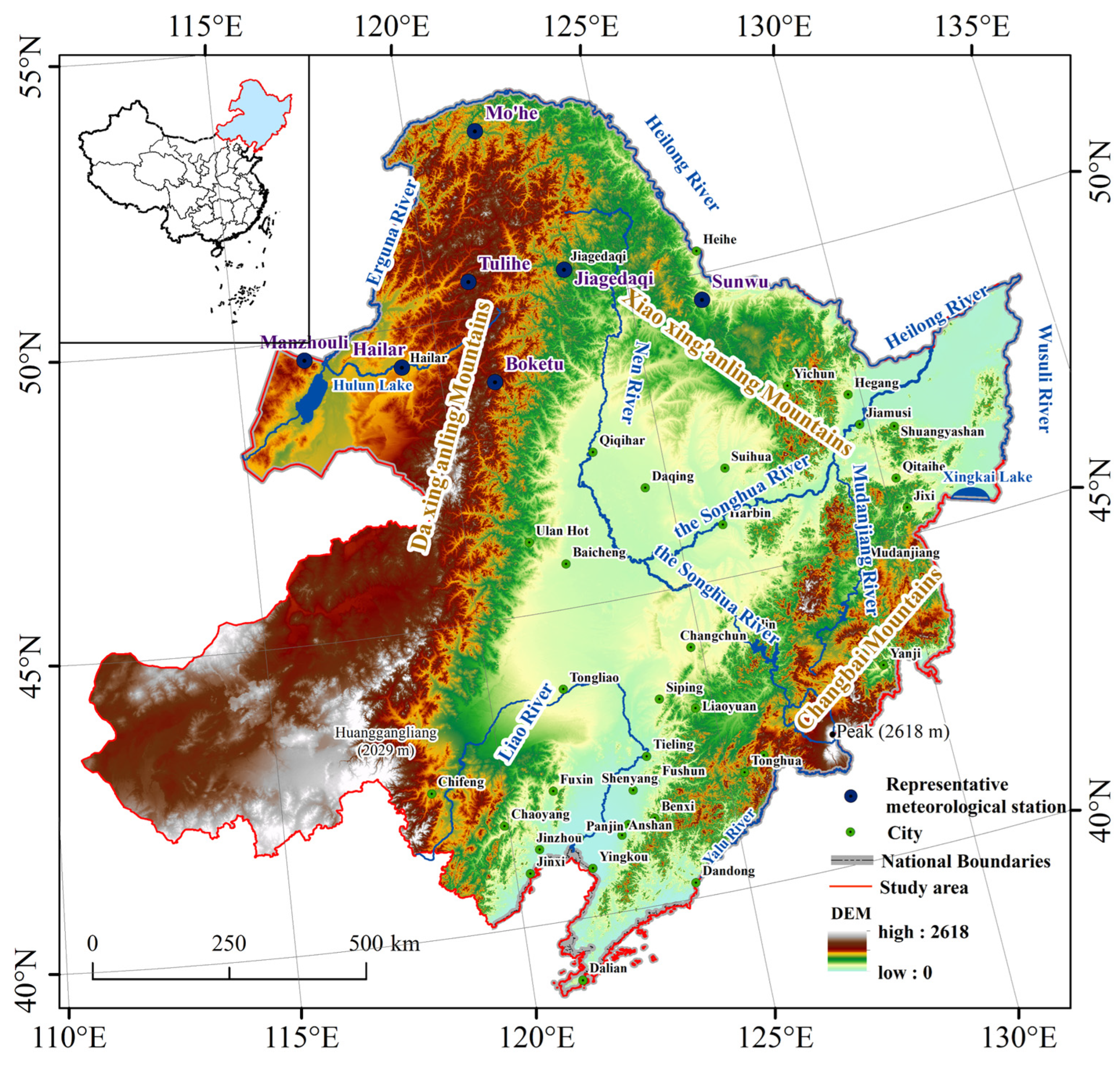
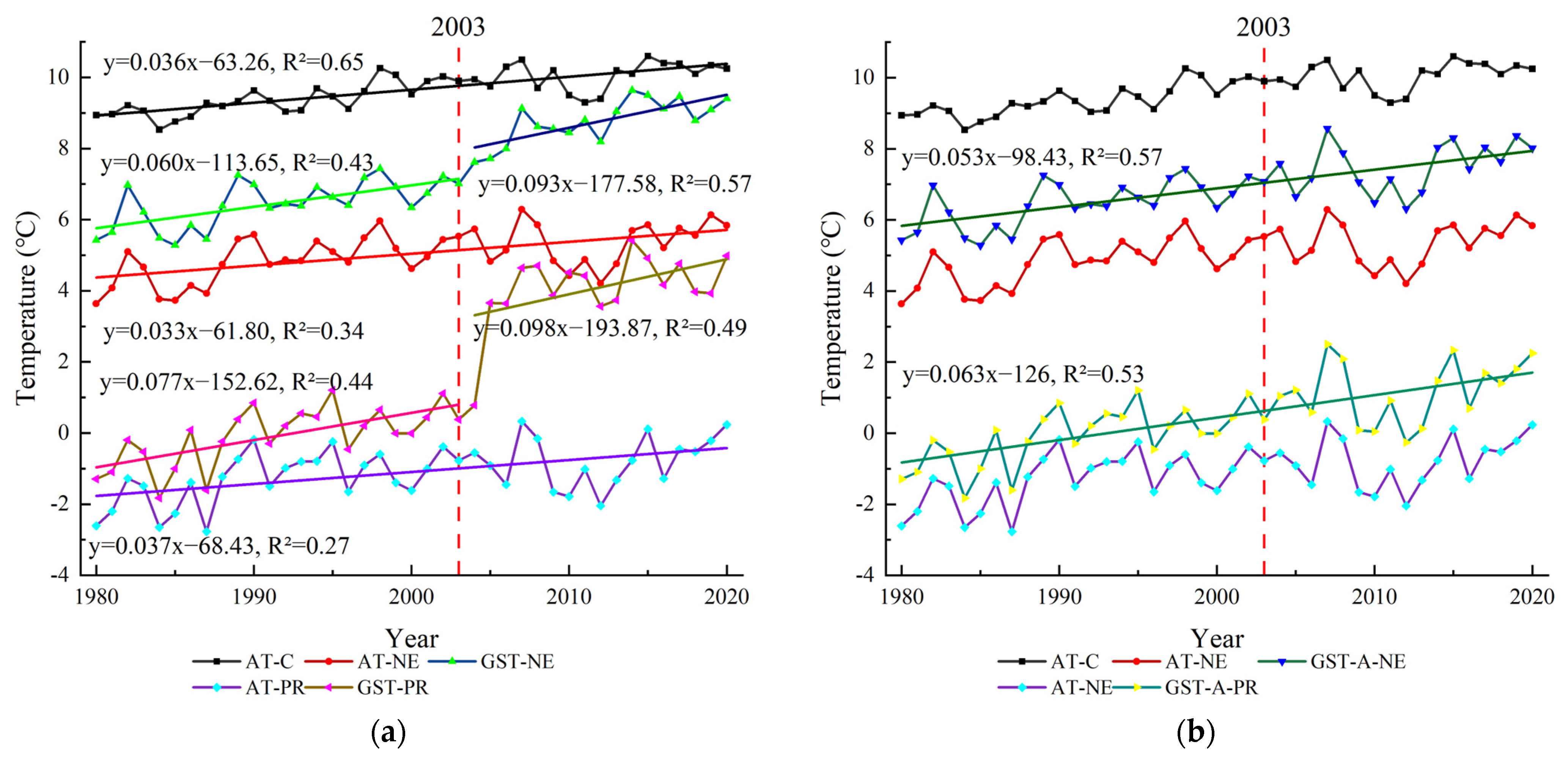
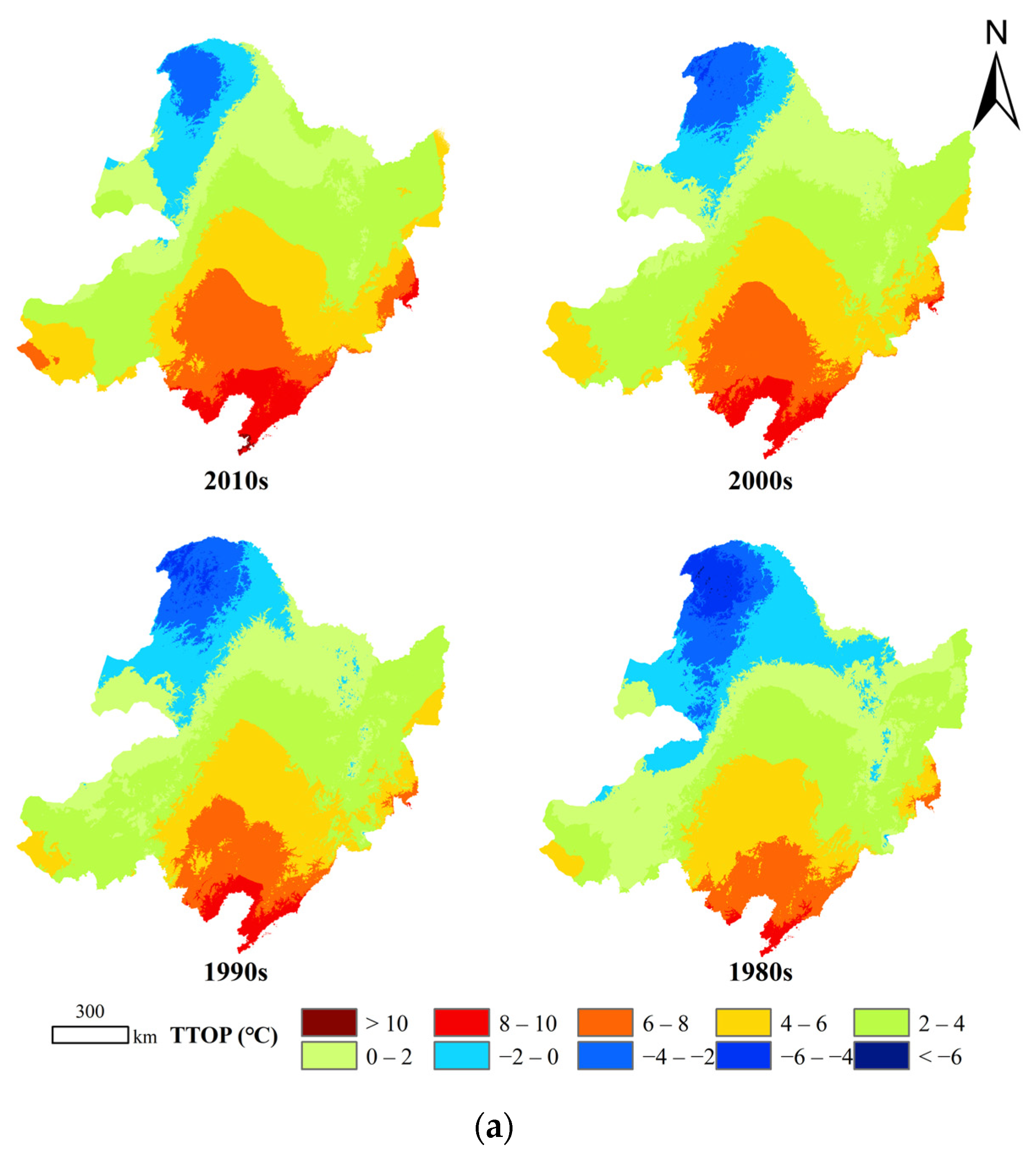
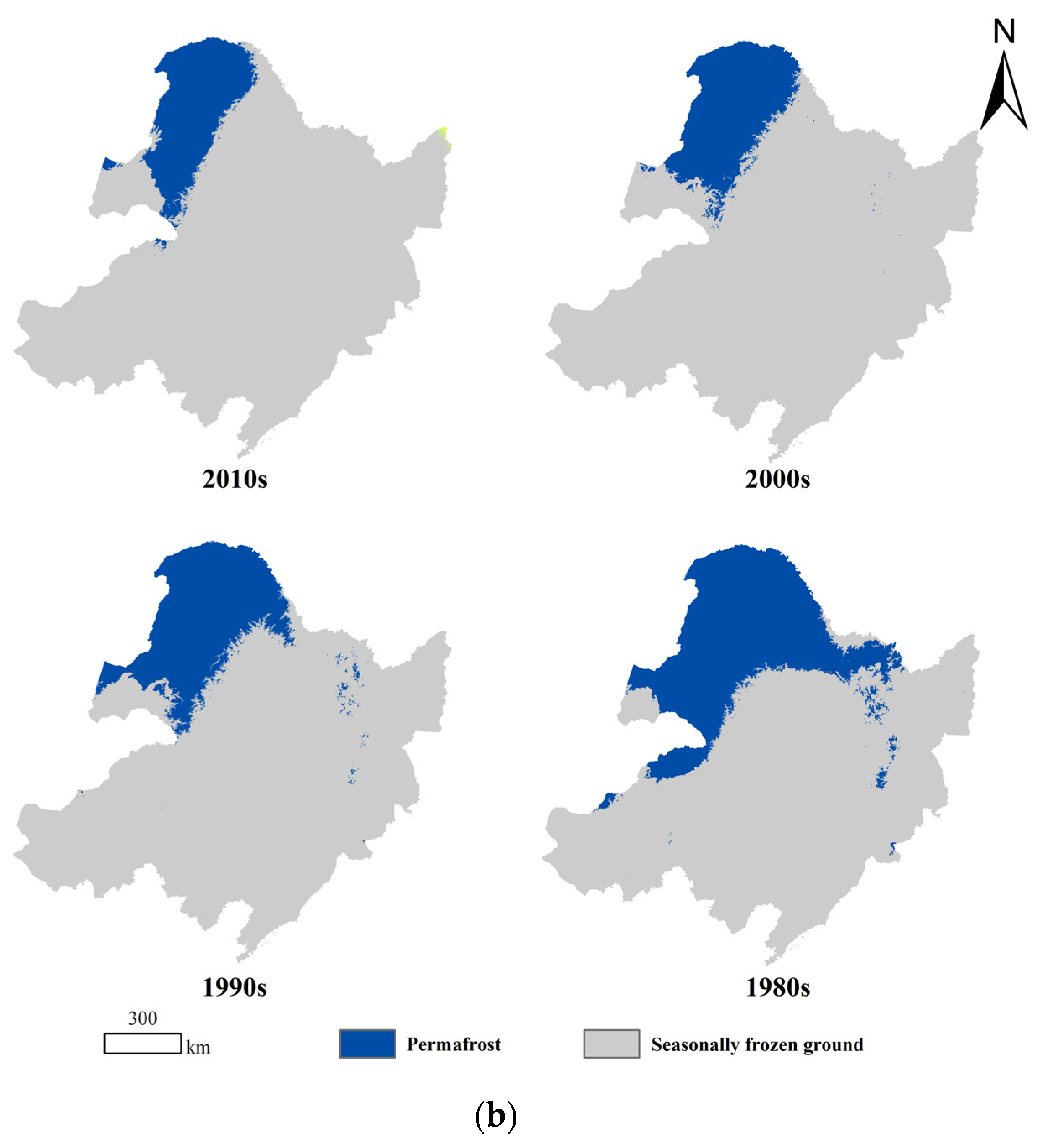
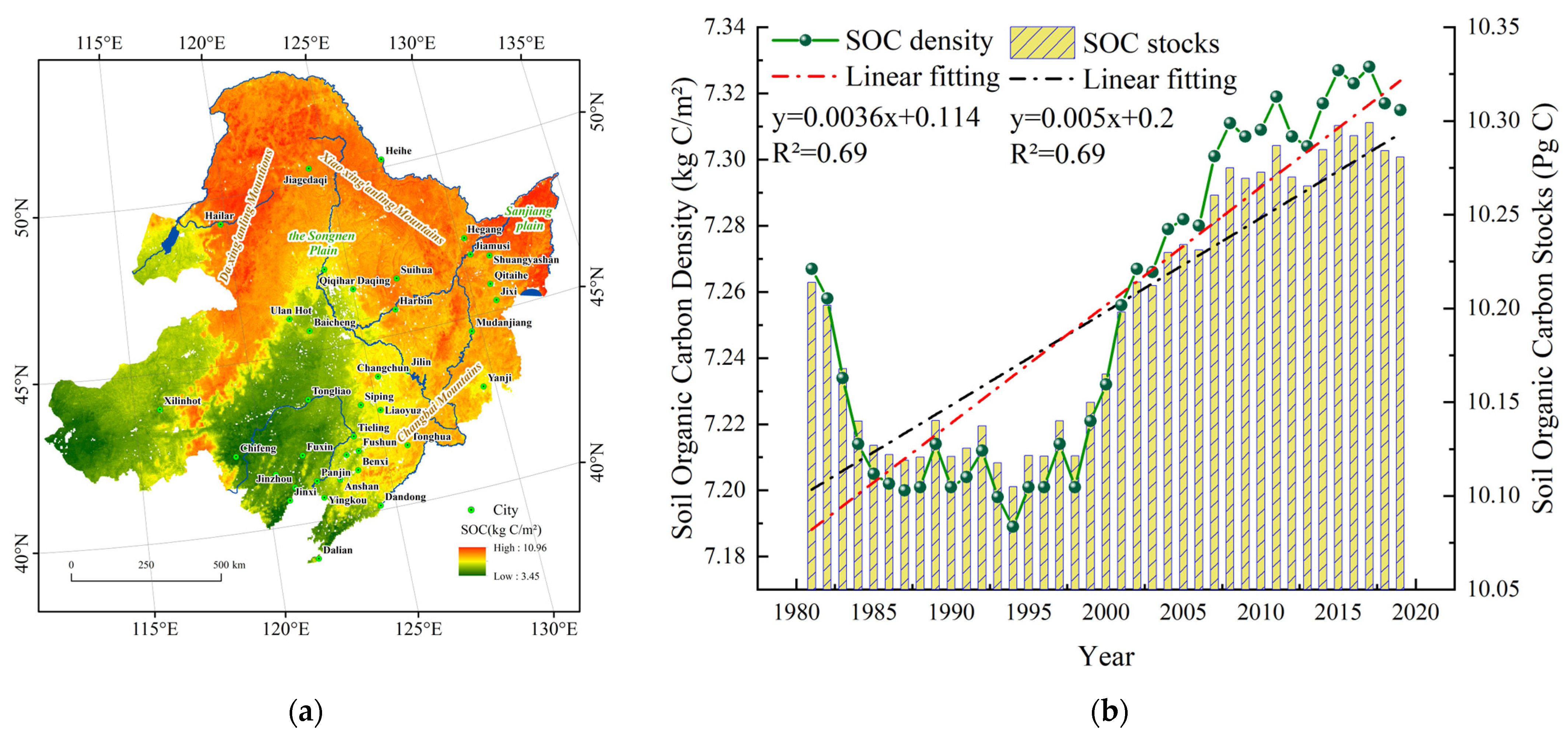
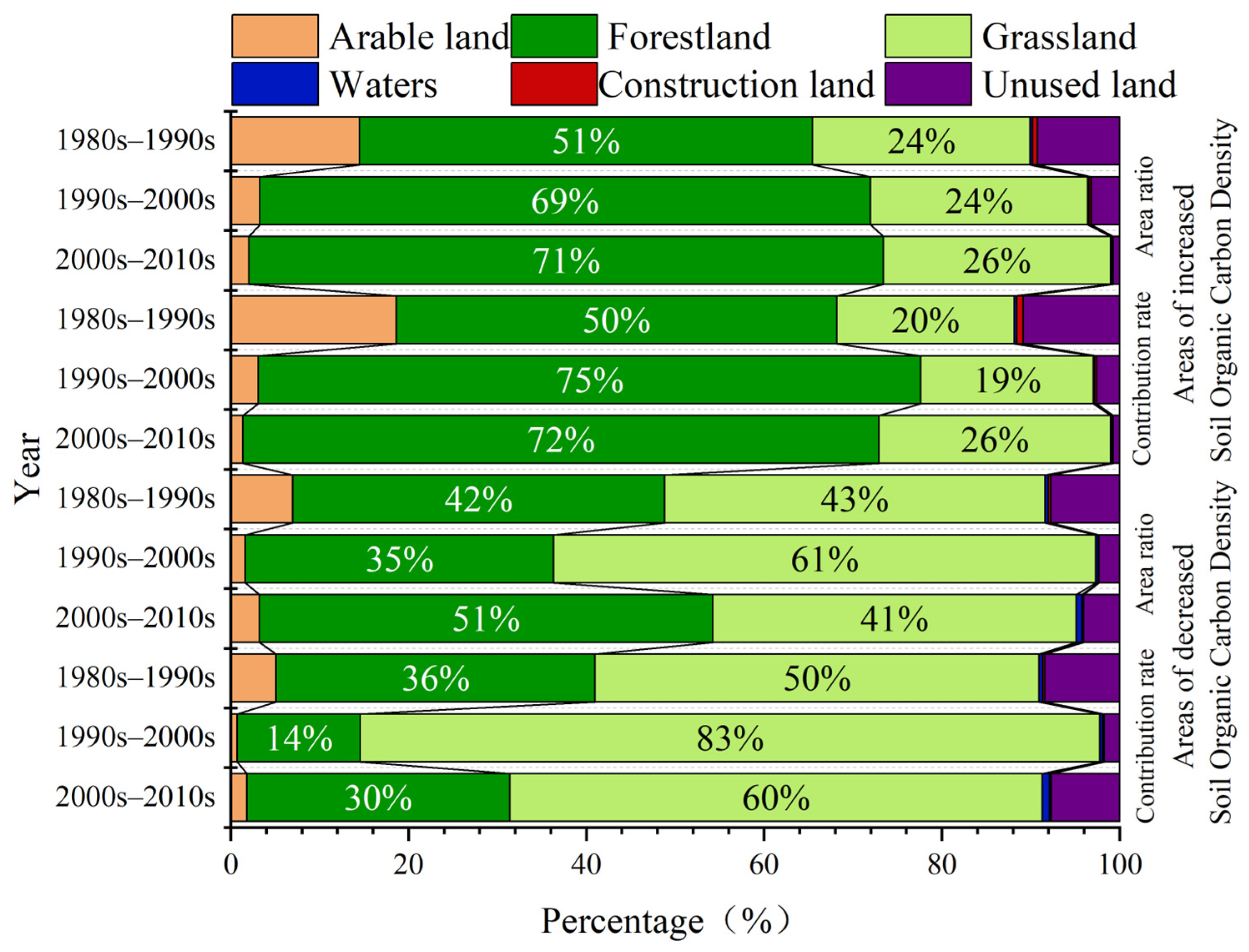
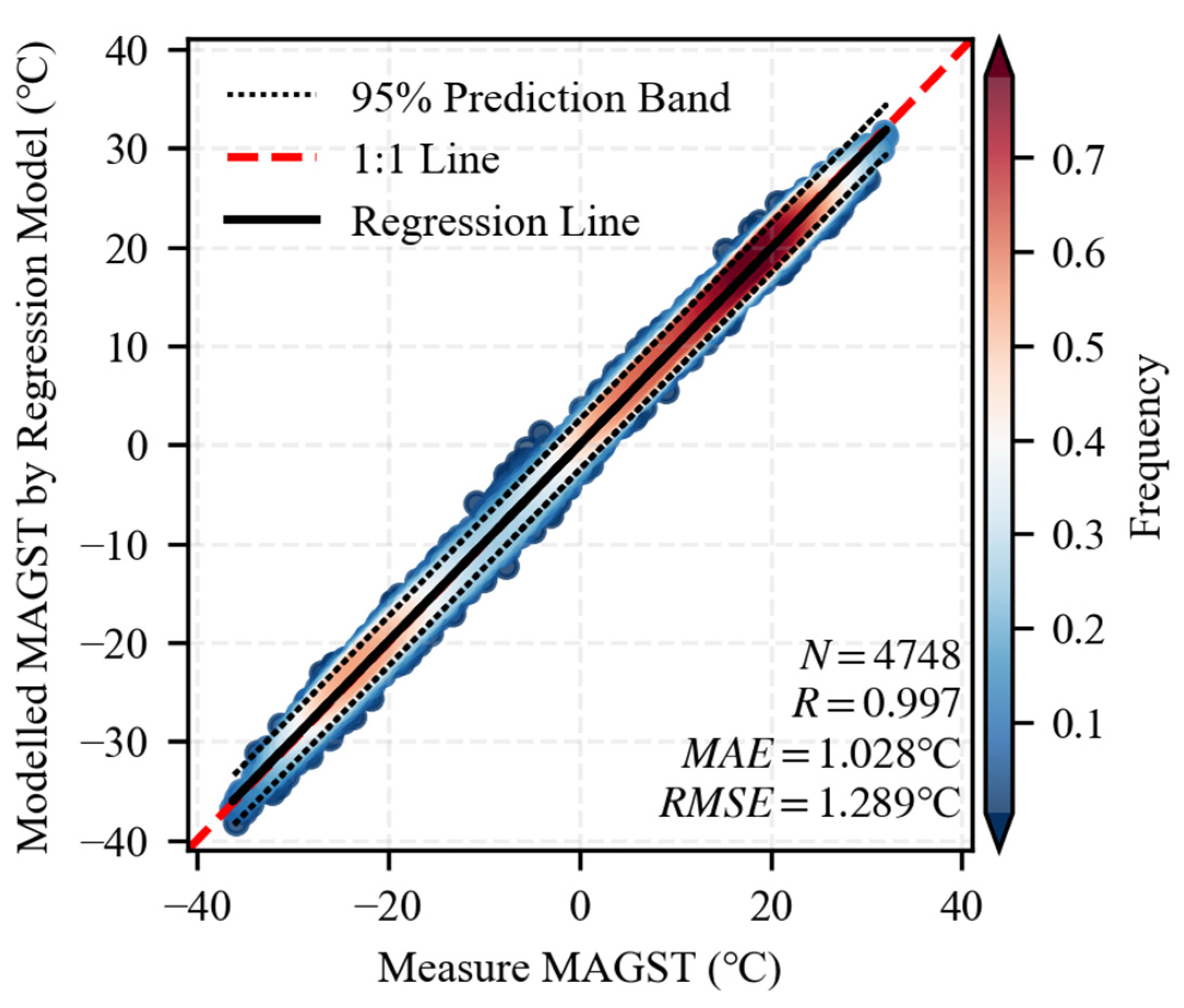
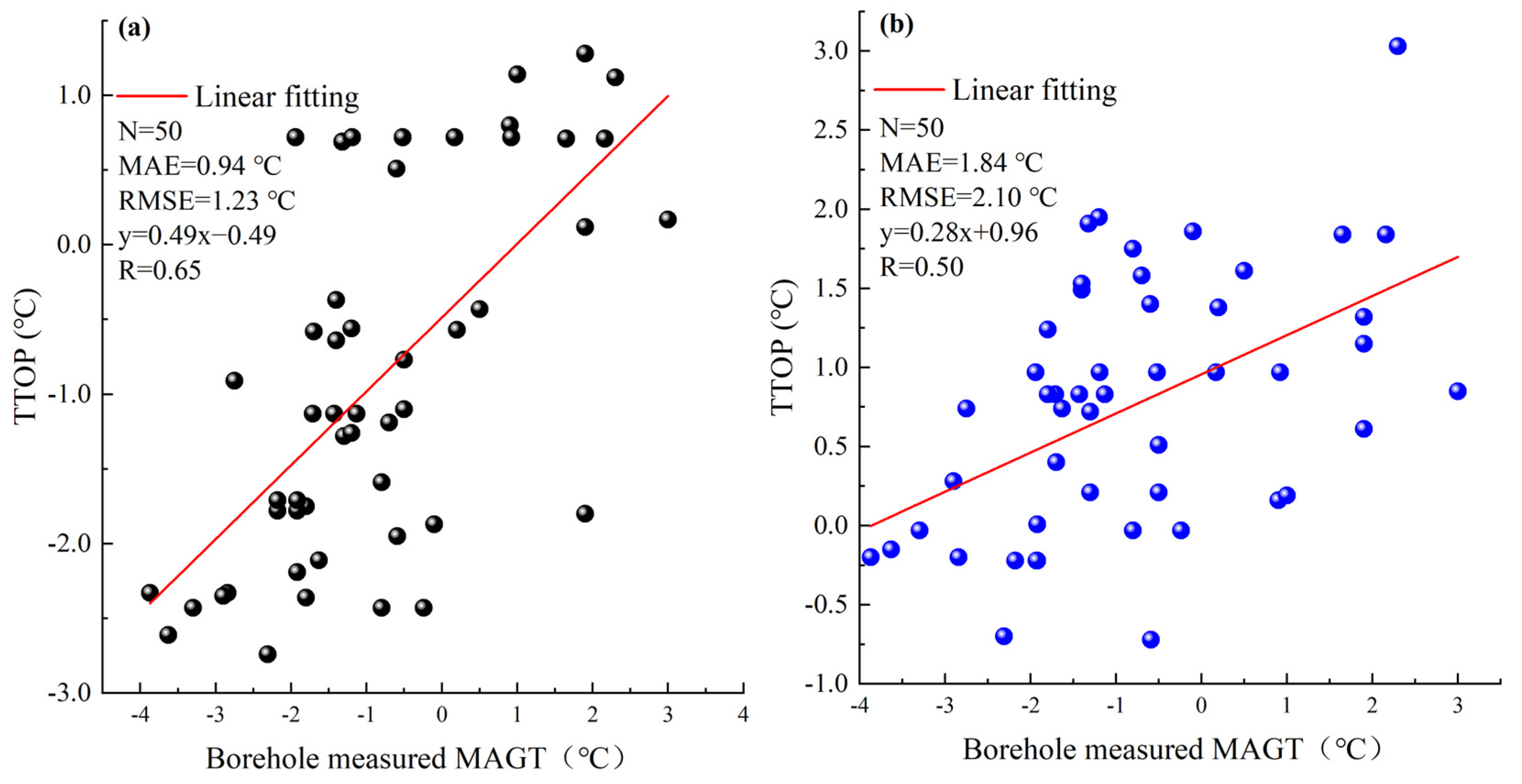
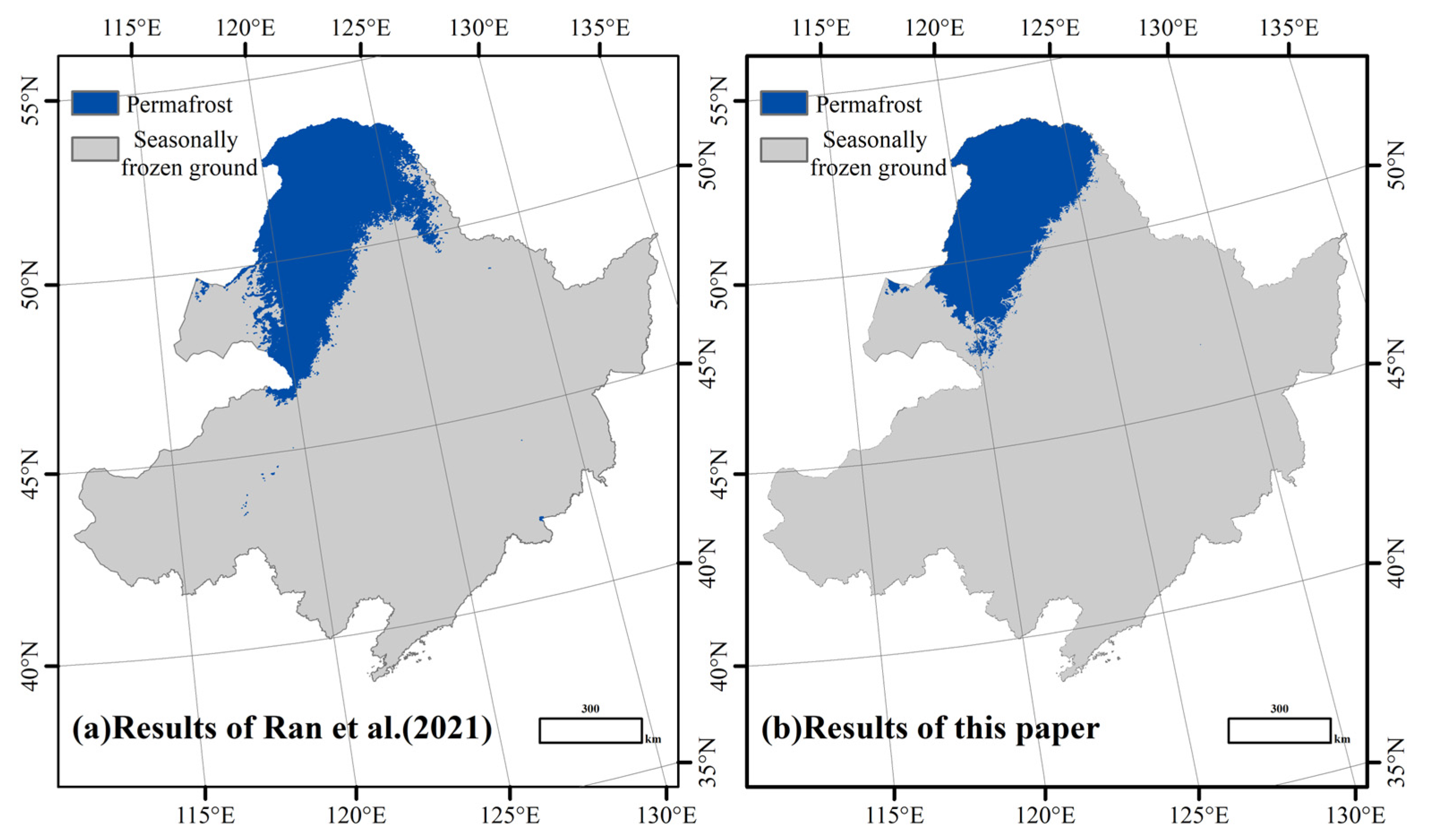
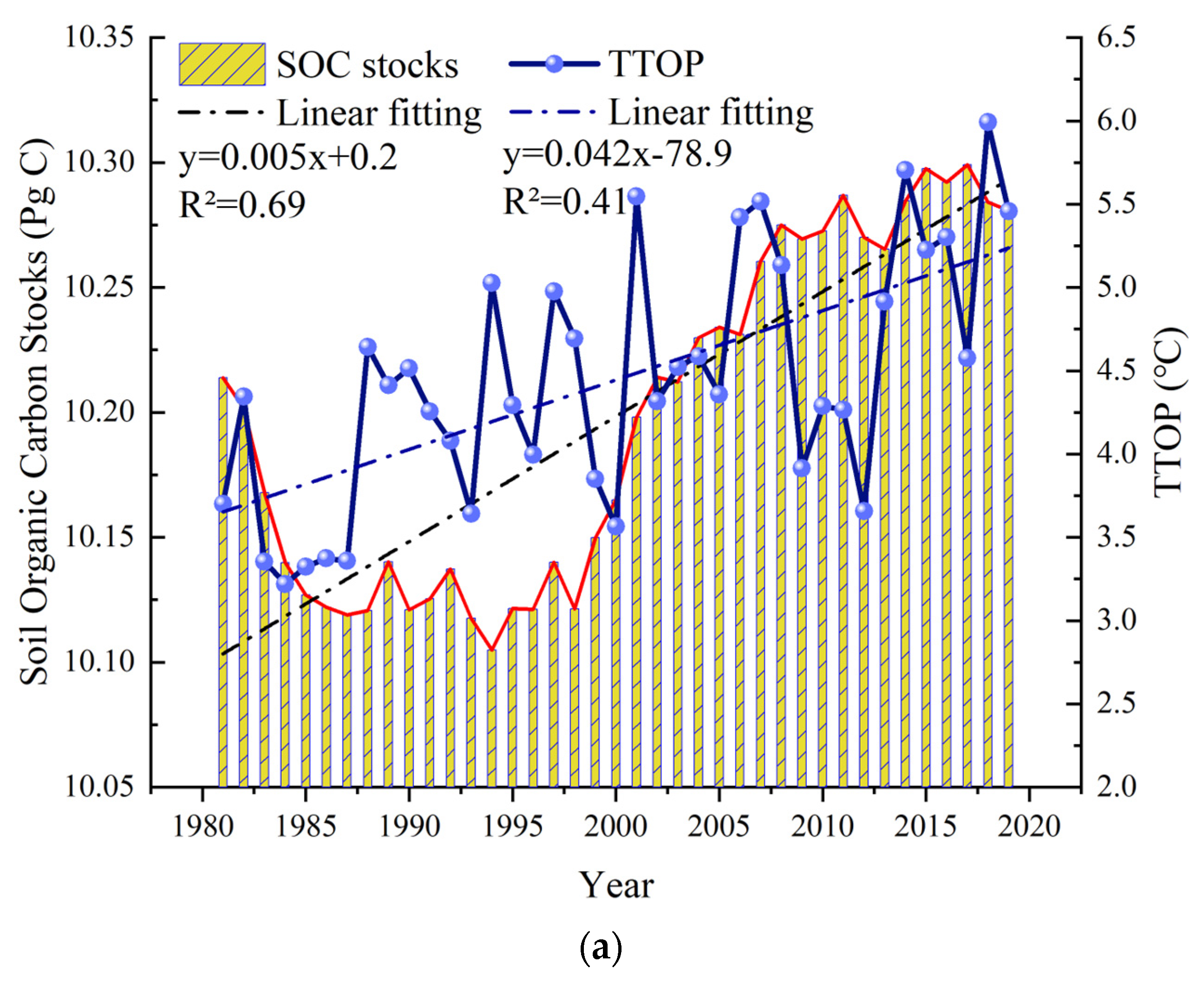
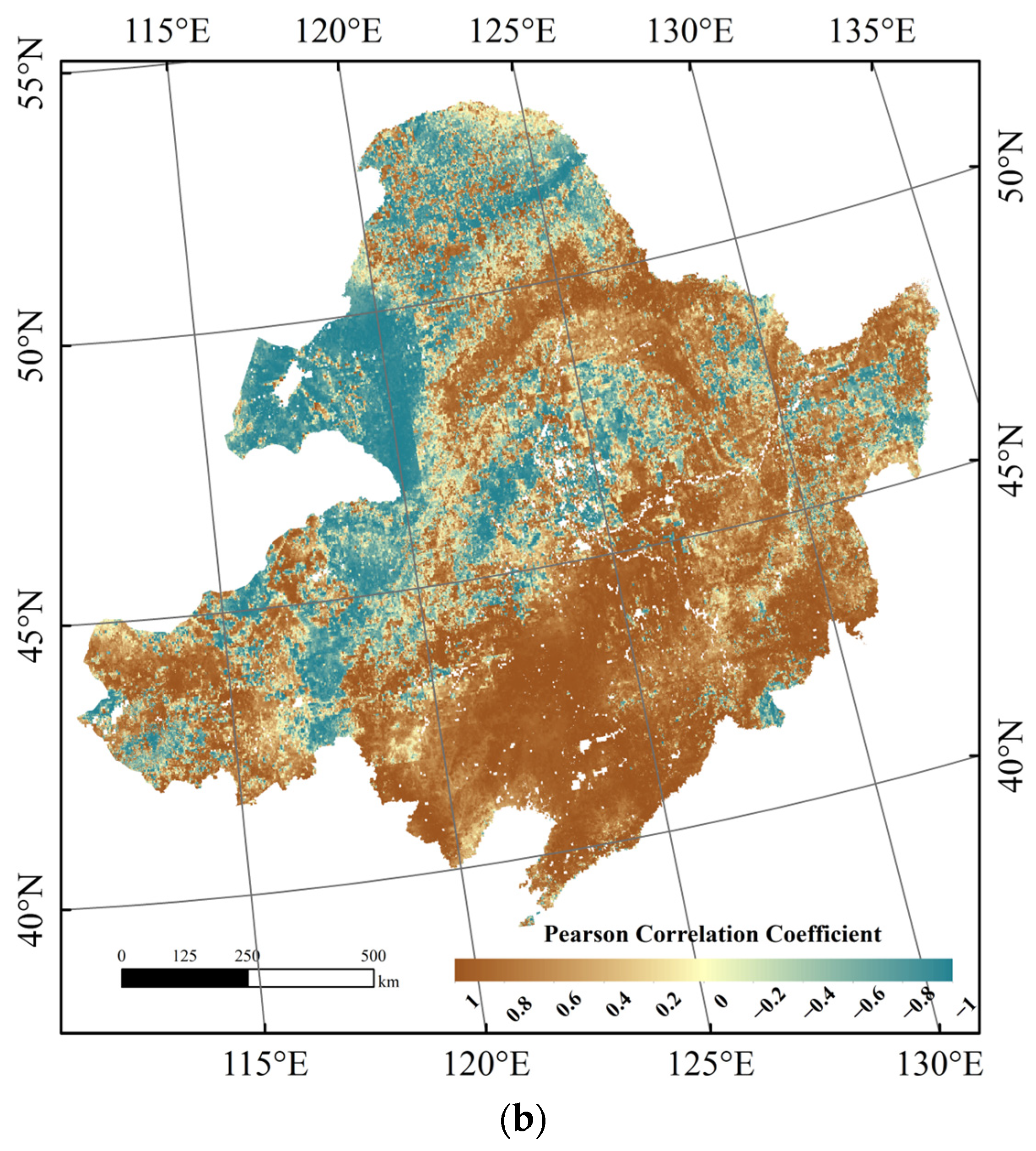
| LULC Types | rk Value | LCCS Classification System Number |
|---|---|---|
| Bare areas | 0.95 | 140, 150, 152, 153, 200, 201, 202 |
| Grasslands and croplands | 0.75 | 10, 11, 12, 20, 130 |
| Shrubs | 0.80 | 120, 121, 122 |
| Deciduous forest | 0.95 | 50, 60, 61, 62, 70, 71, 72, 80, 81, 82 |
| Wetlands | 0.55 | 180 |
| Urban land | 0.70 | 190 |
| Station | Longitude (°E) | Latitude (°N) | Elevation (m) |
|---|---|---|---|
| Mo’he | 122.52 | 52.97 | 439.7 |
| Tulihe | 121.68 | 50.48 | 733.7 |
| Jiagedaqi | 124.12 | 50.40 | 371.7 |
| Manzhouli | 117.32 | 49.58 | 661.8 |
| Hailar | 119.70 | 49.25 | 649.6 |
| Sunwu | 127.35 | 49.43 | 234.5 |
| Boketu | 121.92 | 48.77 | 739.7 |
| Year | Maximum (°C) | Minimum (°C) | Average (°C) | ||
|---|---|---|---|---|---|
| Northeast China | Actual observed data | 1980–2003 | 7.44 | 5.28 | 6.45 |
| 2004–2020 | 9.63 | 7.61 | 8.77 | ||
| 1980–2020 | 9.63 | 5.28 | 7.41 | ||
| Adjusted data | 1980–2003 | 7.44 | 5.28 | 6.45 | |
| 2004–2020 | 8.56 | 6.30 | 7.49 | ||
| 1980–2020 | 8.56 | 5.28 | 6.88 | ||
| permafrost regions | Actual observed data | 1980–2003 | 1.21 | −1.29 | −0.08 |
| 2004–2020 | 4.98 | 0.78 | 4.10 | ||
| 1980–2020 | 4.98 | −1.29 | 1.65 | ||
| Adjusted data | 1980–2003 | 1.21 | −1.29 | −0.08 | |
| 2004–2020 | 2.50 | −0.26 | 1.18 | ||
| 1980–2020 | 2.50 | −1.29 | 0.44 | ||
| Year | LULC | Permafrost | ||||||||||||
|---|---|---|---|---|---|---|---|---|---|---|---|---|---|---|
| Arable Land | Forestland | Grassland | Waters | Construction Land | Unused Land | |||||||||
| SOCS (Pg C) | Proportion (%) | SOCS (Pg C) | Proportion (%) | SOCS (Pg C) | Proportion (%) | SOCS (Pg C) | Proportion (%) | SOCS (Pg C) | Proportion (%) | SOCS (Pg C) | Proportion (%) | SOCS (Pg C) | Proportion (%) | |
| 1980s | 2.32 | 22.86 | 4.14 | 40.86 | 2.75 | 27.12 | 0.13 | 1.30 | 0.17 | 1.65 | 0.63 | 6.22 | 3.18 | 31.34 |
| 1990s | 2.59 | 25.56 | 4.01 | 39.67 | 2.64 | 26.06 | 0.12 | 1.19 | 0.17 | 1.68 | 0.59 | 5.85 | 2.15 | 21.26 |
| 2000s | 2.65 | 25.89 | 4.05 | 39.64 | 2.64 | 25.82 | 0.12 | 1.17 | 0.18 | 1.74 | 0.59 | 5.74 | 1.66 | 16.23 |
| 2010s | 2.74 | 26.72 | 3.96 | 38.59 | 2.52 | 24.59 | 0.11 | 1.09 | 0.23 | 2.21 | 0.70 | 6.81 | 1.46 | 14.17 |
| Year | LULC | |||||
|---|---|---|---|---|---|---|
| Arable Land | Forestland | Grassland | Waters | Construction Land | Unused Land | |
| 1980–2000 | 45.23 | −7.91 | −1.76 | 19.82 | 17.33 | −3.26 |
| 1990–2010 | 50.68 | −1.25 | −0.24 | −8.55 | 27.45 | −0.51 |
| 2000–2020 | 10.84 | −1.86 | −9.33 | −8.47 | 72.97 | 184.07 |
| Year | Subject | Areas of Permafrost Degradation | Northeast China | Proportion (%) | Subject | Areas of Permafrost Degradation | Northeast China | Proportion (%) |
|---|---|---|---|---|---|---|---|---|
| 1980s–1990s | Areas of increased SOC (km2) | 3.77 × 104 | 61.66 × 104 | 6.11 | Areas of reduced SOC (km2) | 8.75 × 104 | 78.60 × 104 | 11.13 |
| Total increase in SOC stocks (Tg C) | 2.05 | 44.33 | 4.63 | Total reduction in SOC stocks (Tg C) | 8.14 | 68.52 | 11.88 | |
| Total area (km2) | 12.52 × 104 | 140.26 × 104 | 8.92 | The total amount of change in SOC stocks (Tg C) | −6.09 | −24.18 | 25.17 | |
| 1990s–2000s | Areas of increased SOC (km2) | 3.90 × 104 | 106.22 × 104 | 3.66 | Areas of reduced SOC (km2) | 1.99 × 104 | 34.04 × 104 | 5.84 |
| Total increase in SOC stocks (Tg C) | 3.91 | 121.10 | 3.23 | Total reduction in SOC stocks (Tg C) | 1.93 | 18.26 | 10.57 | |
| Total area (km2) | 5.88 × 104 | 140.26 × 104 | 4.19 | The total amount of change in SOC stocks (Tg C) | 1.98 | 102.84 | 1.93 | |
| 2000s–2010s | Areas of increased SOC (km2) | 2.50 × 104 | 97.36 × 104 | 2.57 | Areas of reduced SOC (km2) | 1.17 × 104 | 42.90 × 104 | 2.72 |
| Total increase in SOC stocks (Tg C) | 1.42 | 75.81 | 1.88 | Total reduction in SOC stocks (Tg C) | 0.66 | 21.42 | 3.07 | |
| Total area (km2) | 3.67 × 104 | 140.26 × 104 | 2.62 | The total amount of change in SOC stocks (Tg C) | 0.77 | 54.39 | 1.41 | |
| Subject | Permafrost Growth Areas | Northeast China | Proportion (%) | Subject | Permafrost Growth Areas | Northeast China | Proportion (%) | |
| 2000s–2010s | Areas of increased SOC (km2) | 0.55 × 104 | 97.36 × 104 | 0.56 | Areas of reduced SOC (km2) | 0.71 × 104 | 42.90 × 104 | 1.66 |
| Total increase in SOC stocks (Tg C) | 0.24 | 75.81 | 0.32 | Total reduction in SOC stocks (Tg C) | 0.47 | 21.42 | 2.20 | |
| Total area (km2) | 1.26 × 104 | 140.26 × 104 | 0.90 | The total amount of change in SOC stocks (Tg C) | −0.23 | 54.39 | −0.42 |
| Site | Longitude (°E) | Latitude (°N) | Borehole Measured MAGT (°C) | TTOP (°C) | TTOP (°C) by Obu, J. et al. (2019) [7] |
|---|---|---|---|---|---|
| CW1 | 123.98 | 53.33 | −1.63 | −2.11 | 0.74 |
| CW3 | 124.58 | 52.99 | −0.1 | −1.87 | 1.86 |
| CW4 | 124.51 | 52.74 | 1.9 | −1.8 | 1.32 |
| CW5 | 124.58 | 52.54 | −1.8 | −1.75 | 1.24 |
| CW6 | 124.66 | 52.43 | −0.8 | −1.59 | 1.75 |
| CW7 | 124.66 | 52.06 | −0.7 | −1.19 | 1.58 |
| CW8 | 124.53 | 51.81 | −0.5 | −1.1 | 0.21 |
| CW9 | 124.39 | 51.70 | −1.3 | −1.28 | 0.21 |
| CW10 | 124.27 | 51.47 | −2.75 | −1.26 | 0.74 |
| CW12 | 124.21 | 51.21 | −1.3 | −0.91 | 0.72 |
| CW13 | 124.31 | 50.70 | 1.9 | 0.12 | 0.61 |
| CW14 | 124.21 | 50.47 | 3 | 0.17 | 0.85 |
| CW15 | 124.65 | 49.77 | 2.3 | 1.12 | 3.03 |
| XL1 | 124.39 | 51.69 | −1.13 | −1.13 | 0.83 |
| XL2 | 124.39 | 51.69 | −1.71 | −1.13 | 0.83 |
| XL3 | 124.39 | 51.69 | −1.43 | −1.13 | 0.83 |
| GH1 | 121.51 | 50.94 | −0.24 | −2.43 | −0.03 |
| GH2 | 121.51 | 50.94 | −0.8 | −2.43 | −0.03 |
| GH3 | 121.50 | 50.93 | −3.87 | −2.33 | −0.20 |
| GH4 | 121.50 | 50.93 | −2.84 | −2.33 | −0.20 |
| GH5 | 121.53 | 50.80 | −0.59 | −1.95 | −0.72 |
| GH6 | 121.50 | 50.80 | −1.92 | −2.19 | 0.01 |
| GH9 | 121.51 | 50.94 | −3.3 | −2.43 | −0.03 |
| YT1 | 121.55 | 50.63 | −2.18 | −1.78 | −0.22 |
| YT2 | 121.55 | 50.63 | −1.92 | −1.78 | −0.22 |
| DW01 | 124.19 | 53.21 | 0.2 | −0.57 | 1.38 |
| DW02 | 124.20 | 53.19 | −1.2 | −0.56 | 1.95 |
| DW04 | 124.42 | 53.10 | 0.5 | −0.43 | 1.61 |
| DW05 | 124.57 | 53.00 | −1.4 | −0.37 | 1.49 |
| DW06 | 124.49 | 52.69 | −0.5 | −0.77 | 0.51 |
| DW07 | 124.69 | 52.23 | −0.6 | 0.51 | 1.40 |
| DW08 | 124.66 | 52.03 | −1.4 | −0.64 | 1.53 |
| DW09 | 124.34 | 51.59 | −1.7 | −0.58 | 0.40 |
| DW10 | 124.33 | 50.90 | 0.9 | 0.8 | 0.16 |
| DW11 | 124.34 | 50.74 | 1 | 1.14 | 0.19 |
| DW12 | 124.29 | 50.60 | 1.9 | 1.28 | 1.15 |
| MH1 | 122.02 | 53.03 | −2.9 | −2.35 | 0.28 |
| MH2 | 122.02 | 53.02 | −1.8 | −2.36 | 0.83 |
| NE2 | 125.14 | 51.13 | −1.94 | 0.72 | 0.97 |
| NE3 | 125.14 | 51.13 | 0.92 | 0.72 | 0.97 |
| NE4 | 125.14 | 51.12 | 2.16 | 0.71 | 1.84 |
| NE5 | 125.15 | 51.15 | −1.32 | 0.69 | 1.91 |
| YTLH1 | 121.55 | 50.63 | −2.18 | −1.71 | −0.22 |
| YTLH2 | 121.55 | 50.63 | −1.93 | −1.71 | −0.22 |
| MG | 122.28 | 52.28 | −2.31 | −2.74 | −0.70 |
| ALS | 121.90 | 51.89 | −3.63 | −2.61 | −0.15 |
| P1 | 125.14 | 51.13 | −0.52 | 0.72 | 0.97 |
| P2 | 125.14 | 51.13 | −1.19 | 0.72 | 0.97 |
| P3 | 125.14 | 51.13 | 0.17 | 0.72 | 0.97 |
| P4 | 125.14 | 51.12 | 1.65 | 0.71 | 1.84 |
| Average Value | −0.81 | −0.89 | 0.75 | ||
Disclaimer/Publisher’s Note: The statements, opinions and data contained in all publications are solely those of the individual author(s) and contributor(s) and not of MDPI and/or the editor(s). MDPI and/or the editor(s) disclaim responsibility for any injury to people or property resulting from any ideas, methods, instructions or products referred to in the content. |
© 2023 by the authors. Licensee MDPI, Basel, Switzerland. This article is an open access article distributed under the terms and conditions of the Creative Commons Attribution (CC BY) license (https://creativecommons.org/licenses/by/4.0/).
Share and Cite
Song, Y.; Huang, S.; Zhang, H.; Wang, Q.; Ding, L.; Liu, Y. The Impact of Permafrost Change on Soil Organic Carbon Stocks in Northeast China. Forests 2024, 15, 14. https://doi.org/10.3390/f15010014
Song Y, Huang S, Zhang H, Wang Q, Ding L, Liu Y. The Impact of Permafrost Change on Soil Organic Carbon Stocks in Northeast China. Forests. 2024; 15(1):14. https://doi.org/10.3390/f15010014
Chicago/Turabian StyleSong, Yang, Shuai Huang, Haiying Zhang, Qin Wang, Lin Ding, and Yanjie Liu. 2024. "The Impact of Permafrost Change on Soil Organic Carbon Stocks in Northeast China" Forests 15, no. 1: 14. https://doi.org/10.3390/f15010014
APA StyleSong, Y., Huang, S., Zhang, H., Wang, Q., Ding, L., & Liu, Y. (2024). The Impact of Permafrost Change on Soil Organic Carbon Stocks in Northeast China. Forests, 15(1), 14. https://doi.org/10.3390/f15010014






